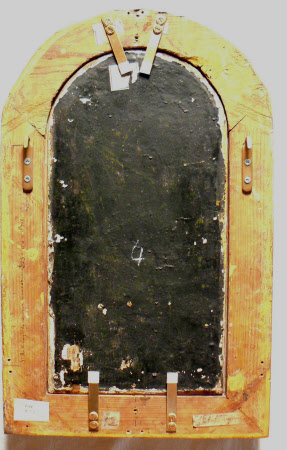Saint Anthony Abbot (c.251-356)
Italian (Venetian) School
Category
Art / Oil paintings
Date
1500 - 1550
Materials
Oil on panel
Measurements
381 x 194 mm (15 x 7 ⅝ in)
Place of origin
Venice
Order this imageCollection
Ham House, Surrey
NT 1140140
Summary
Oil painting on panel, Saint Anthony Abbot (c.251-356) by Italian (Venetian) School, 1st half of 16th century. Small, whole-length figure, turned to the left, in a white, sleeved tunic and brown mantle, with a cowl over his head and extending down over his shoulders, holding an open book in his right hand and a staff and a bell in his left, and a pig bottom left. Its companion, or pendant, depicts Saint Sebastian as was also once attributed to Leonardo da Vinci. Saint Antony Abbot (so-called to distinguish him from Saint Anthony of Padua) was born c. 251 at Coma (Qeman) and died on Mount Kolzim – both in Egypt – in 356. Revered (with slight exaggeration) as the founder of monasticism, his feast day is 17 January. He was patron saint of basketmakers, and invoked by sufferers of the disease ‘St Antony’s fire’ (erysipelas). He began in the classic way of a ‘desert father’ by retiring into the desert in Lower Egypt as a hermit, but attracted so many followers that he eventually persuaded them to live under a common rule, though not yet as a laura, or community. His life was written by St Athanasius, Bishop of Alexandria, with whom he had combated the Arian heresy. It was filled with stories of his temptations by the devil, which proved a fertile source for artists. His usual attributes are a tame pig (whom he freed from diabolic possession), a tau – or T-shaped – staff or cross (a symbol of immortality in Ancient Egypt), and a bell (traditionally used to drive off demons).
Provenance
In 1683, 1727 and 1820 inventories and thence by descent until acquired in 1948 by HM Government when Sir Lyonel, 4th Bt (1854 – 1952) and Sir Cecil Tollemache, 5th Bt (1886 – 1969) presented Ham House to the National Trust, and entrusted to the care of the Victoria & Albert Museum, until 1990, when returned to the care of the National Trust, and to which ownership was transferred in 2002
Credit line
Ham House, The Dysart Collection (purchased by HM Government in 1948 and transferred to the National Trust in 2002)
Marks and inscriptions
Verso: St. Anthony by Leonara Davinshaw £25.0.0.Pret. - inscription on back of frame in pen Verso: Label inscribed in ink: 12 St Anthony; 19th-century label inscribed: B / 2733
Makers and roles
Italian (Venetian) School , artist previously catalogued as attributed to Leonardo da Vinci (Vinci 1452 - Amboise 1519), artist


